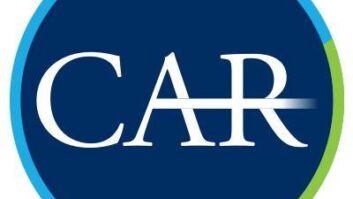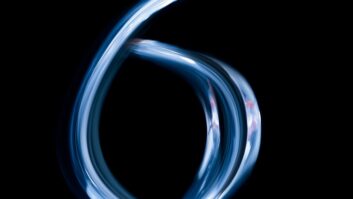LOS ANGELES Many engineers with facilities on Mount Wilson are reacting to the recent wildfires that nearly claimed their main broadcast sites, taking steps to bolster disaster preparedness.
The Mount Wilson telecommunications antenna farm, one of the busiest and largest broadcast antenna sites in the nation, was spared damage from the wildfires that spread across the San Gabriel Mountains in late August and early September.

A dramatic webcam image from the evening of Aug. 29 captures the glow of fires as well as facility lights. ©UCLA Department of Physics and Astronomy Mount Wilson, approximately 25 miles northeast of downtown Los Angeles, is home to nearly every Class B FM in the city — 20 FMs in all. The cluster at the mountaintop facility, located within Angeles National Forest, includes broadcast and two-way communication antennas.
Approximately a dozen broadcast towers dot the 5,700-foot peak, which is also home to the Mount Wilson Observatory and Park. Local engineers say the site is an RF tangle like no other.
Fire reached to within a quarter-mile of the broadcast site, engineers said, threatening transmitter buildings. Local broadcast historians recall the location has been threatened before, as in the early 1990s.
Observers were left to speculate about how bad the damage could have been.
At stake for broadcasters was millions of dollars in capital loss, said Tony Neece, president of the Mount Wilson Fire Safe Council, a group formed by communications tenants earlier this year to launch improved fire prevention initiatives.
“Had the fire burned over Mount Wilson, the damage would have ranged from moderate to catastrophic, depending on several factors.
“Masonry buildings with sound, fire-resistant roofs, closed eaves and overhangs, with all air intakes screened and other wall openings filled with fire-safe foam, probably would have survived without major damage,” Neece said.
Restoration of burned-out facilities likely would have been delayed due to the continued threat of fire and the fragile conditions of roadways to the site, Neece said.
In addition to broadcasters, there are numerous other communications sites on Mt. Wilson, which if lost would have severely interrupted commerce affecting the infrastructure and economy of Southern California, Neece said.
This year’s close call left broadcast engineers here reassessing their auxiliary transmitter sites and wondering what might have happened had wildfire disabled Mount Wilson for a long period of time.
“There is no question that we are now in evaluation mode and rethinking strategies,” said Saul Perez, chief engineer for KPWR(FM).
The Emmis station has a full-power backup on Flint Peak in Glendale, Calif., approximately 30 miles from Mount Wilson, a safe distance from the recent wildfires.
Perez said Emmis spent money beefing up the backup site before the recent wildfire, adding better monitoring and modulation gear recently.
“We really consider that more of an alternate main site than a backup. It we ever had to broadcast from that site for an extended period of time we could sustain ourselves very well.”
Some broadcasters find themselves with low-power backup transmitter sites that are not suitable for a long-term fix if needed, several area engineers said.

CBS has a range of backup options, including a disaster vehicle with a 2,000-watt frequency agile transmitter that can be used in a pinch as a radio station on wheels. ©Fred Holub, CBS Radio, Los Angeles “We are always in disaster preparedness mode and have had disaster plans in place. This was a good test of our plans,” said Scott Mason, director of engineering for CBS Radio in Los Angeles.
‘Diverse backup sites’
CBS Radio’s four Mount Wilson FMs have auxiliary transmitters in the Verdugo Mountains, Mason said.
“We believe in geographically diverse backup sites for all of our FMs.”
CBS has a range of backup options, Mason said, including a disaster vehicle with a 2,000-watt frequency agile transmitter that can be used in a pinch as a radio station on wheels.
The 30-foot truck features a transmitter cabinet and a studio, a 60-foot mast, built-in generator, transmitter and Armstrong wideband antenna, Mason said. “We had (the truck) in place during the fire. It’s our toolbox on wheels.”
Despite the auxiliary site options, CBS is not satisfied with its current situation.
“We initially built the back-up sites just to stay on the air in the metro. That won’t be good enough over a long haul if we had to use it for six to 12 months. We are working to find the capital to build aux sites to maximum available power,” Mason said.
Norm Avery, chief engineer for Citadel’s KLOS(FM), said, “One of our main concerns was the ingestion of soot and debris by our transmitter for KLOS on Mount Wilson. As a precaution we shut down Mount Wilson for about a week and switched to our backup transmitter on Mount Harvard, which doesn’t use outdoor air for cooling, only conditioned air.” Mount Harvard is less than one mile from Mount Wilson but was not threatened by the wildfire.
“Our Mount Wilson transmitter currently uses about 35 percent outdoor air,” Avery said.
Since the fire, Citadel has placed orders for two new solid-state transmitters, which will be enclosed within a building that will circulate its own conditioned air, he said.
“We will have a huge new level of protection at Mount Wilson,” Avery added.
Clear Channel already had plans in place to consolidate backup sites for its four Mount Wilson FMs even before the fire this fall, said Terry Grieger, chief engineer for the company in Los Angeles.
Mount Wilson FM Station List KAMP – CBS
KBIG – Clear Channel
KCBS – CBS
KHHT – Clear Channel
KHTV – Venture Technologies
KIIS – Clear Channel
KKGO – Mt. Wilson FM Broadcasters
KKLA – Salem Communications
KLOS – Citadel
KLVE – Univision
KOST – Clear Channel
KPCC – Pasadena CC
KPFK – Pacifica Foundation
KPWR – Emmis Communications
KRTH – CBS
KSCA – Univision
KSWD – Bonneville
KTWV – CBS
KUSC – University of Southern Calif.
KXOS – Emmis
Source: Dennis Doty, transmitter engineer for NBC Universal in Los Angeles “Just this year we approved a new ERI combiner system at our Briarcrest auxiliary site in the Hollywood Hills. It turned out the new FM combiner was delivered during the first week of the fire.”
A crew from Electronics Research Inc. including President/CEO Tom Silliman arrived within days to tune the combiner and test the new auxiliary site.
“We crammed a lot of work into just a few days time, but the backup transmitter site was ready if we needed to utilize it,” Grieger said.
Access
Clear Channel also called in one of its mobile emergency response vehicles. The vehicle, usually stationed in San Diego, has a frequency agile 5,000-watt transmitter, antenna, processing equipment, satellite-delivered audio system and generator.
“Perfect in a pinch for getting a station up on the air quickly,” Grieger said.
Tom Koza, engineering manager for Univision in Los Angeles, said since the fires, the broadcaster has decided to invest in a permanent auxiliary broadcast site for its two Mount Wilson FMs. “After a full review we are now pursuing options at Flint Peak.”
Lack of access to the Mount Wilson broadcast sites during and in the weeks following the fires has caused concern for broadcasters.
“We would have been unable to reach our Mount Wilson site even if it had been damaged,” said Citadel’s Perez. “We are working to develop relationships with law enforcement and CalTran (California Department of Transportation) to make sure we have proper permits and credentials for access.”
Radio World reported in the Sept. 9 issue that the Society of Broadcast Engineers is talking to the Federal Emergency Management Agency and other parties to figure out the best way to accomplish such a goal in all states.
Ongoing effort
The non-profit Mount Wilson Fire Safe Council applied for and was granted $200,000 in state grants for fire prevention work, including clearing of overgrown brush, according to the Los Angeles Times.
However, that money was not received prior to the wildfire this fall, officials told the newspaper.
Fire experts have advised the group also to consider construction of a fire buffer zone around the perimeter of the communications site, the report concluded.
Local observers said Southern California’s rainy season, which begins in January, likely will bring a new challenge for broadcasters.
“With so much vegetation burned away, there is very little holding the soil together. It is easy to imagine mud slides this winter that could render Mount Wilson inaccessible by the mountain road,” said CBS Radio’s Scott Mason. “At least it will wash away the orange fire retardant from the mountainsides that was left behind.”
Mount Wilson hosted its first radio station transmitter site in 1946 when the former KFI(FM) signed on the air.
At the time this story went to print, the so-called Station fire, the one that most threatened Mount Wilson, was 98 percent contained, according to fire officials.
Two firefighters died in fighting the fire, which was believed to have been set, when their truck plunged off a mountain road.












